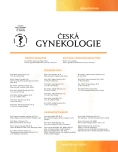Urinary incontinence: vaginal delivery versus instrumental delivery
Authors:
P. Pičmanová 1,2; M. Procházka 3
Authors‘ workplace:
Ústav pro studium odborných předmětů a praktických dovedností, Fakulta zdravotnických věd, Univerzita Palackého, Olomouc, přednosta doc. PaedDr. M. Kopecký, Ph. D.
1; Centrum vědy a výzkumu, Fakulta zdravotnických věd, Univerzita Palackého, Olomouc, ředitel centra prof. MUDr. V. Janout, CSc.
2; Ústav porodní asistence, Fakulta zdravotnických věd, Univerzita Palackého, Olomouc, pověřená vedením ústavu Mgr. Š. Bubeníková
3
Published in:
Ceska Gynekol 2020; 85(4): 271-274
Category:
Overview
Objective: An overview of urinary incontinence issues after vaginal delivery versus instrumental delivery.
Design: A review article.
Methods: Compilation of published data from scientific literature.
Setting: Ústav pro studium odborných předmětů a praktických dovedností, Fakulta zdravotnických věd, Univerzita Palackého v Olomouci. Centrum vědy a výzkumu, Fakulta zdravotnických věd, Univerzita Palackého v Olomouci.
Conclusion: Pregnancy and childbirth can lead to injuries of the pelvic floor muscles. The age of the firstborn in the pelvic floor disorders is similar to that of the end of pregnancy. Surgical vaginal delivery is an important part of modern obstetric practice. This serves to facilitate the delivery of the head. Includes vacuumextraction (VEX) and forceps. Forceps-assisted delivery has a lower failure rate than vacuum-assisted delivery but is associated with a higher incidence of maternal pelvic floor trauma.
Keywords:
urinary incontinence – vaginal delivery – instrumental delivery – forceps – ventouse – vakuum
Sources
1. Baskett, TF. Operative vaginal delivery – an historical perspective. Best Prac Res Clin Obstet Gynaecol., 2018, 56, p. 3–10. doi: 10.2016/j.bpobpgyn.2018.08.002.
2. Belkov, A., Huser, M., Pastorčáková, M., Sedláková, K. Poporodní inkontinence, těhotenství a porod a jejich vztah k ženské močové inkontinenci. Urol praxi, 2011, 12, 5, s. 307–312.
3. Black, M., Murphy, DJ. Forceps delivery for non-rotational and rotational operative vaginal delivery. Best Pract Res Clin Obstet Gynaecol, 2019, 56, p. 55–68, doi: 10.1016/j.bpobgyn.2019.2.002.
4. Horčička, L., et al. Inkontinence moči v každodenní praxi. 2. vyd. Mladá fronta, a. s., 2017.
5. Morávková, P., Hruban, L., Jančářová, D., et al. Porodnické vaginální extrakční operace a jejich vliv na traumatismus matky a dítěte – prospektivní studie. Čes Gynek, 2019, 84, 2, s. 93–98.
6. Pařízek, A. Porodnické kleště – překonaná porodnická technika? Čes Gynek, 2010, 75, 5, s. 408–416.
7. Pilka, R. Gynekologie. Praha: Maxdorf, 2017.
8. Romžová, M. Možné příčiny vzniku inkontinence a jejich řešení. Urol praxi, 2014, 15, 5, s. 221–226.
9. Ryšánková, M. Klasifikace inkontinence moče u žen. Klasifikace prolapsu pánevních orgánů. Urol praxi, 2016, 17, 2, s. 72–74.
10. Šimetka, O., Michalec, I. Vakuumextrakce. Čes Gynek, 2010, 75, 5, s. 417–422.
11. Šimetka, O, Michalec, I. Operační vaginální porod. Čes Gynek, 2016, 81, 2, s. 129–133.
12. Tähtinen, RM., Cartwringht, R., Venooij, RWM., et al. Longterm risks of stress and urgency urinary incontinence after different vaginal delivery modes. Obstet Gynecol, 2019, 220, 2, p. 181e1–181e8.
13. Urbánková, I., Grohregin, K., Hanacek, J., et al. The effect of the first vaginal birth on pelvic floor anatomy and dysfunction. Int Urogynecol, 2018, 30, 10, s. 1689–1696. doi: 10/1007/s00192-019- 04044-2.1
14. Vašek, P., Gärtner, M., Szabová, O., Juráková, M. Močová inkontinence v těhotenství. Čes Gynek, 2019, 84, 1, s. 73–76.
15. Wesnes, SL., Lose, G. Preventing urinary incontinence during pregnancy and postpartum: a review. Int Urogynecol J., 2013, 24, 6, p. 889–899, doi: 10.1007/s00192-012-2017-3.
Labels
Paediatric gynaecology Gynaecology and obstetrics Reproduction medicineArticle was published in
Czech Gynaecology

2020 Issue 4
Most read in this issue
- Cesarean scar defect – manifestation, diagnostics, treatment
- What next in cervical cancer screening?
- Assisted reproductive methods – current status and perspectives
- Benefits of exercise in the prenatal and postnatal period
